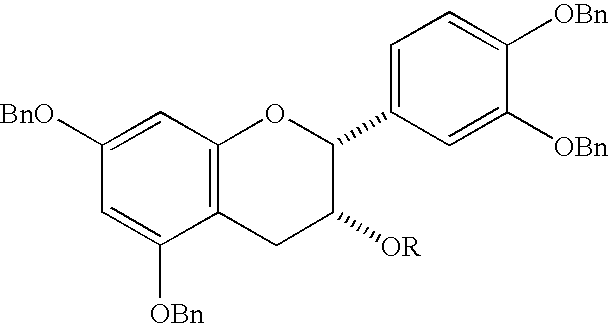Synthesis of 4alpha-arylepicatechins
a technology of arylepicatechins and arylepicatechins, which is applied in the field of polyphenolic products, can solve the problems of increasing the complexity of the structural structure of the proanthocyanidins with the length of the chain, the inability to isolate pure proanthocyanidins from natural sources, and the inability to develop a considerable amount of time, so as to achieve the effect of easy separation
- Summary
- Abstract
- Description
- Claims
- Application Information
AI Technical Summary
Benefits of technology
Problems solved by technology
Method used
Image
Examples
example 1
Preparation of 3,5,7,3′,4′-penta-O-benzylepicatechin
To a suspension of 180 mg (4.5 mmol) of sodium hydride (60% in oil) in 10 mL of dry N,N-dimethylformamide (Tuickmantel et al. J. Am. Chem. Soc. 1999, 121, 12073-12081) was added at room temperature a solution of 2.60 g (4.00 mmol) of 5,7,3′,4′-tetra-O-benzylepicatechin in 10 mL of dry N,N-dimethylformamide. After 1 hour, 0.56 mL (4.7 mmol) of benzyl bromide was added. The mixture was stirred overnight, poured into ice water, and extracted with 3 times 50 mL of dichloromethane. The combined organic phases were washed with water and brine, dried over magnesium sulfate, and evaporated. The residue was purified by column chromatography (dichloromethane / ethyl acetate / hexane 1:1:6) to give 2.20 g (74%) of the product as a colorless, amorphous solid: [α]D−30.7°, [α]546−37.2° (c 6 gL−1, ethyl acetate); 1H NMR (CDCl3) δ 7.48-7.25 (m, 20H), 7.19 (s, 1H), 7.17-7.12 (m, 3H), 7.04-6.97 (m, 2H), 6.91 (narrow ABq, 2H), 6.27, 6.25 (ABq, 2H, J=2 ...
example 2
Preparation of 3,5,7,3′,4′-penta-O-benzyl-4-hydroxyepicatechin
To a solution of 2.20 g (3.38 mmol) of 3,5,7,3′,4′-penta-O-benzylepicatechin in 20 mL of tetrahydrofuran and 0.16 mL (8.9 mmol) of water was added at room temperature 2.00 g (7.4 mmol) of 2,3-dichloro-5,6-dicyano-p-benzoquinone. The mixture was stirred overnight, then 0.91 g (7.4 mmol) of 4-(dimethylamino)pyridine was added, stirring was continued for 5 min, and 20 g of silica gel was added. After evaporation, the residue was filtered over silica gel (ethyl acetate / hexane 1:4, then dichloromethane / ethyl acetate / hexane 1:1:4) to give 1.05 g (47%) of the product as a white foam: [α]D+6.6°, [α]546+7.2° (c 10 gL−1, ethyl acetate); 1H NMR (CDCl3) δ 7.50-7.28 (m, 20H), 7.20-7.11 (m, 4H), 7.04-6.92 (m, 4H), 6.30 (narrow m, 2H), 5.20 (s, 2H), 5.09 (narrow ABq, 2H), 5.06 (s, 2H), 5.03 (s, 1H), 5.01 (s, 2H), 4.95 (narrow m, 1H), 4.39, 4.25 (ABq, 2H, J=12 Hz), 3.70 (narrow m, 1H), 2.41 (d, 1H, J=2 Hz); 13C NMR (CDCl3) δ 160.32, 15...
example 3
Preparation of (2R,3S)-3,5,7,3′,4′-pentakis(benzyloxy)flavan-4-one
To a solution of 1.00 g (1.32 mmol) of 3,5,7,3′,4′-penta-O-benzyl-4-hydroxyepicatechin in 8 mL of dry dichloromethane was added at room temperature 300 mg of 4 Å molecular sieves, 180 mg (1.54 mmol) of N-methylmorpholine-N-oxide, and 58 mg (165 μmol) of tetrapropylammonium perruthenate. The reaction mixture was stirred overnight and evaporated, and the residue was purified by column chromatography (ethyl acetate / dichloromethane / hexane 1:1:10) to give 0.66 g (66%) of the ketone as a white foam: αD−47.9°, α546−58.5° (c 10 gL−1, ethyl acetate); 1H NMR (CDCl3) δ 7.67-7.38 (m, 20H), 7.27 (s, 1H), 7.24-7.22 (m, 3H), 7.12-7.10 (m, 2H), 7.02 (m, 2H), 6.33 (d, 1H, J=2.1 Hz), 6.29 (d, 1H, J=2.1 Hz), 5.34 (d, 1H, J=1.2 Hz), 5.26 (d, 2H), 5.24 (s, 2H), 5.14 (s, 2H), 5.09 (s, 2H), 4.78 (d, 1H, J=12.0 Hz), 4.50 (d, 1H, J=12.0 Hz), 3.85 (d, 1H, J=1.8 Hz); 13C NMR (CDCl3) δ 187.59, 165.12, 164.53, 161.71, 149.06, 148.96, 137.37, 13...
PUM
 Login to View More
Login to View More Abstract
Description
Claims
Application Information
 Login to View More
Login to View More - R&D
- Intellectual Property
- Life Sciences
- Materials
- Tech Scout
- Unparalleled Data Quality
- Higher Quality Content
- 60% Fewer Hallucinations
Browse by: Latest US Patents, China's latest patents, Technical Efficacy Thesaurus, Application Domain, Technology Topic, Popular Technical Reports.
© 2025 PatSnap. All rights reserved.Legal|Privacy policy|Modern Slavery Act Transparency Statement|Sitemap|About US| Contact US: help@patsnap.com



